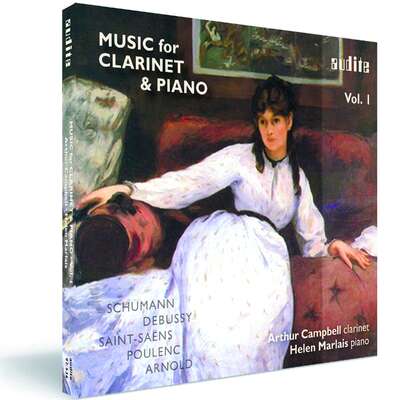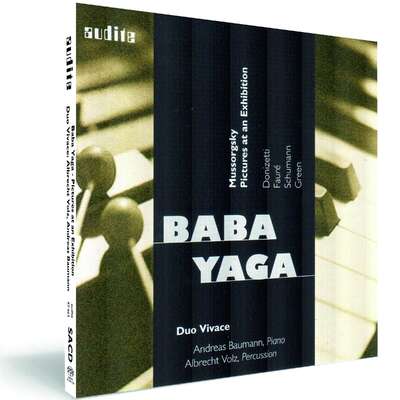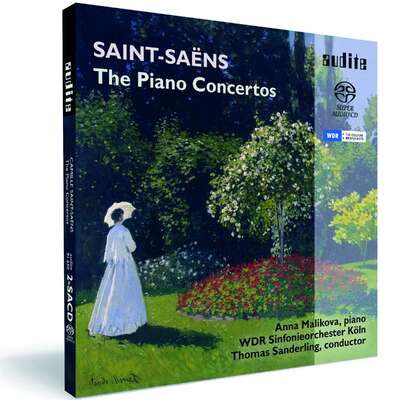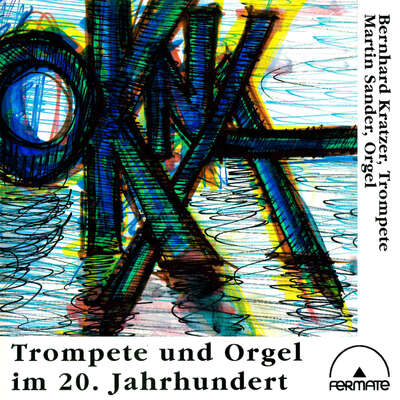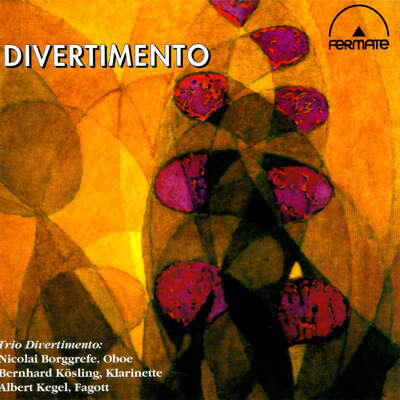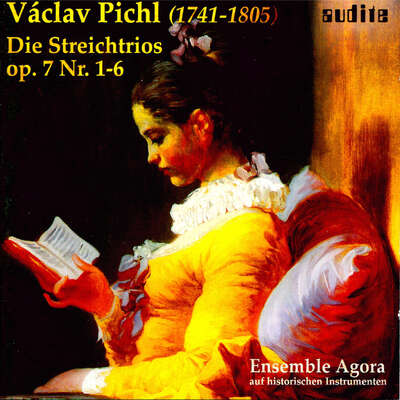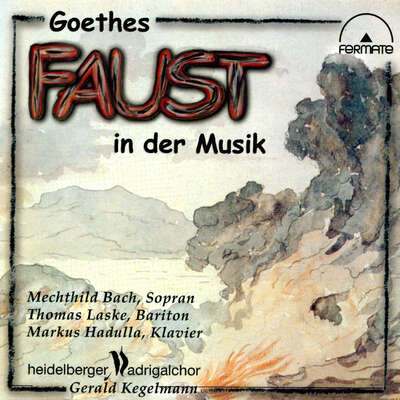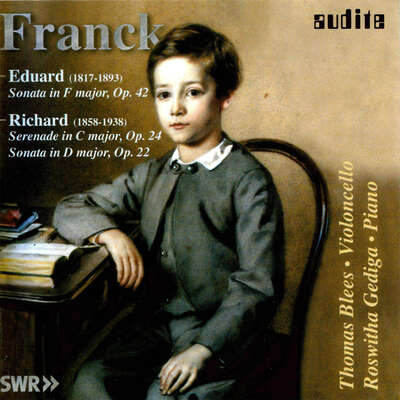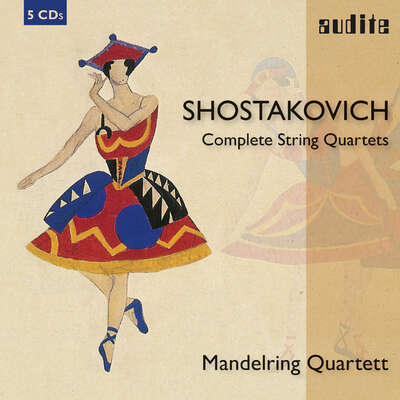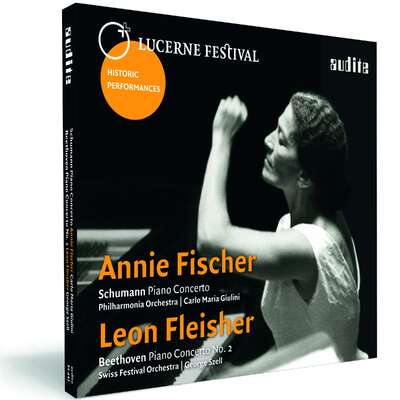
This recording of works by German, French and British composers, spanning two centuries, demonstrates the manifold abilities of the clarinet and piano as a recital duo. This is the first in a series of recordings that present repertoire for this esteemed instrumental partnership.more
This recording of works by German, French and British composers, spanning two centuries, demonstrates the manifold abilities of the clarinet and piano as a recital duo. This is the first in a series of recordings that present repertoire for this esteemed instrumental partnership.
Details
| Works for Clarinet and Piano by Schumann, Debussy, Saint-Saëns, Poulenc and Arnold | |
| article number: | 97.536 |
|---|---|
| EAN barcode: | 4022143975362 |
| price group: | BCA |
| release date: | 27. January 2012 |
| total time: | 55 min. |
Informationen
Presenting works by German, French and British composers of the nineteenth and twentieth centuries, Arthur Campbell and Helen Marlais (piano) exhibit the enormous dynamic and sonic spectrum of the clarinet. At the heart of this recording are the late works of the three French composers Claude Debussy, Camille Saint-Saëns and Francis Poulenc, who demonstrate equally the gentle and velvety character of the clarinet and the powerful, sometimes penetrating sound of the instrument. The increasing virtuosity which composers demanded from the clarinet during the course of the nineteenth to the twentieth centuries is impressively demonstrated in the final movements of the works on this disc by Robert Schumann, Francis Poulenc and Malcolm Arnold.
Arthur Campbell was born in Canada and studied at the Northwestern University in Michigan, USA, where he was taught by the renowned clarinettist and pedagogue Robert Marcellus. He has won numerous international and national competitions, including the International Clarinet Competition and the National Music Festival of Canada. An internationally sought-after clarinet virtuoso, Arthur Campbell has toured throughout the USA, Canada, Europe and Asia. He regularly presents international masterclasses at universities, conservatoires and conventions. Arthur Campbell was appointed professor at the Grand Valley State University in Michigan, where he has been teaching a class of clarinet students from across the globe.
Reviews
Fanfare | 08.08.2012 | Richard A. Kaplan | August 8, 2012
Arthur Campbell (not to be confused with clarinetists James Campbell or David Campbell) is professor of clarinet at Grand Valley State University inMehr lesen
Do Campbell and his wife, Helen Marlais, bring anything to these pieces that warrants acquisition of yet another clarinet recital CD? In a word, no. Campbell has an attractive enough sound, in a generic way, but his performances are consistently undercharacterized; moreover, there are some technical problems that become troublesome: His trills are too slow, and he has a tendency to blur (dare I say “fudge”?) rapid runs. In the second Schumann piece, he consistently tries to compensate for slow finger technique by starting the most difficult triplet figure too soon, which hardly helps. And, in the Lento of the Saint-Saëns sonata, he overblows the sempre f opening section in the lowest register of the instrument, and his frequent gasps for air become distracting. Stick with David Shifrin, Jonathan Cohler, and the young Anna Hashimoto in this repertoire.
Ensemble - Magazin für Kammermusik | 3-2012 Juni/Juli | Diether Steppuhn | June 1, 2012 Souveräne Zurückhaltung
Junge Musiker stürzen sich gern mit Verve in diese Musik; hier gestaltetMehr lesen
Diverdi Magazin | n°214 (mayo 2012) | Blas Matamoro | May 1, 2012
Una pareja bien avenida
Un variado programa de obras para clarinete y piano en Audite
La redonda, estricta y mixturadamente sensual/heroica sonoridad del clarinete ha venido seduciendo a los músicos, al menos desde el rococó. CantaMehr lesen
Este programa dei dúo clarinete-piano lo muestra con una astuta conformación de su contenido. A las piececitas Biedermeier de Schumann, a quien imaginamos tocándolas con sus amigos, entre ponches de coñac y vaharadas de pipas, se suma fácilmente la rapsodia debussyana, ya que el músico francés - recúrrase a sus preludios para piano - debe a Schumann, y reconocidamente, el gusto por el fragmento, la ráfaga, esa música que viene de algún lado y se escapa hacia otro lado, como quiere Roland Barthes.
Luego tenemos a Saint-Saens, maestro como pocos en saber escribir para cualquier instrumento, cualquier combinación, cualquier formación, siempre con su cautela redaccional, su fraseo de burguesa elegancia, su pudor sentimental y su gusto por la melodía como canto, co mo ilación de una sola voz. De alguna manera, Poulenc es el don Camilo deI siglo XX, devoto de la finura armónica, capaz de voluptuosidades melancólicas y de melancolías voluptuosas, mezcladas con evocaciones del jazz y mínimas fanfarrias de barracón ferial.
Pero la sorpresa es la sonatina de Malcolm Arnold, con un andantino de recatado canto entre dos efusiones bailables. Es la estética temperamental de un inglés, esa mezcla armoniosa de la genteel tradition, de la cortesía ceremonial y su alta dosis de cautela, con el otro extremo del alma inglesa: la extravagancia, lo insular, mirar a lo lejos en el mar y de espaldas al macizo continente.
Fono Forum | Mai 2012 | Clemens Haustein | May 1, 2012 Sonaten-Miteinander
Bei Duo-Sonaten unter Beteiligung von Klavier und einem "solistischen" Instrument stellt sich immer die Frage, wie sehr sich dieses "solistische"Mehr lesen
In dieser Hinsicht spielt der kanadische Klarinettist Arthur Campbell auf dieser CD mit verschiedenen Werken für Klarinette und Klavier so vorbildlich, wie man es selten hört. Er hält sich in Klang und Gestus so sehr zurück, dass mancher Hörer, der den Fokus vor allem auf die Klarinette legt, von so viel Zurückhaltung enttäuscht sein könnte. Wer das Miteinander von Klavier und Blasinstrument verfolgt, wird dagegen begeistert sein. Campbell verschmilzt gleichsam mit dem Klang des Klaviers (Helen Marlais), woraus sich Interpretationen von beeindruckender Geschlossenheit ergeben. Selten hat man den brodelnden Unterbau in der Klavierstimme zu Schumanns Fantasiestücken op. 73 so deutlich wahrgenommen, selten wurden die Schumann'schen Stücke dabei so elegant und zart gespielt. Selten auch fügte sich die Klarinettenstimme in Debussys "Première Rhapsodie" so nahtlos in die impressionistischen Klavierklänge ein. Immer bleibt Campbells und Marlais Spiel exakt, elegant, ohne Übermaß. Die Schönheit dieses tatsächlich gemeinsamen Spiels ist so einnehmend, dass kaum mehr etwas zu fehlen scheint. Nicht einmal romantische Gefühlsausbrüche.
English Translation:
Sonaten-Miteinander ("Sonata Togetherness")
For duo-sonatas with a piano and a ‘soloist’ instrument, the question always arises of how much the ‘solo’ instrument holds back, adapts to the piano, how much it enables the coexistence of two equal partners. Far too often, piano is equated with ‘accompaniment’ while violin, cello, or a wind instrument vigorously trumps. Without even thinking that two belong in this sonata.
In this regard, on this CD the Canadian clarinetist Arthur Campbell plays various works for clarinet and piano so exemplarily [flawlessly] as one seldom hears. He holds back in tone and gesture so much, that many listeners whose focus lies primarily on the clarinet could be disappointed at this reserve. On the other hand, whoever follows the togetherness of piano and wind instrument will be inspired. Campbell virtually fuses with the tone of the piano (Helen Marlais), which results in an interpretation of impressive inclusiveness. Seldom has one so clearly observed the bubbling substructure of the piano part of Schumann’s Fantasy Pieces op. 73 and, thereby, seldom have the Schumann pieces been played so elegantly and delicately. And seldom has the clarinet part in Debussy’s Premier Rhapsody been seamlessly joined with the impressionistic piano tones. Campbell’s and Marlais’ playing is always exact, elegant, without excess. The beauty of this genuinely joint playing is so captivating that it seems to lack for nothing. Not even romantic emotional eruptions outbursts.
Fono Forum | Mai 2012 | Clemens Haustein | May 1, 2012
Sonaten-Miteinander ("Sonata Togetherness")
Translation
For duo-sonatas with a piano and a ‘soloist’ instrument, the question always arises of how much the ‘solo’ instrument holds back, adapts toMehr lesen
In this regard, on this CD the Canadian clarinetist Arthur Campbell plays various works for clarinet and piano so exemplarily as one seldom hears. He holds back in tone and gesture so much, that many listeners whose focus lies primarily on the clarinet could be disappointed at this reserve. On the other hand, whoever follows the togetherness of piano and wind instrument will be inspired. Campbell virtually fuses with the tone of the piano (Helen Marlais), which results in an interpretation of impressive inclusiveness. Seldom has one so clearly observed the bubbling substructure of the piano part of Schumann’s Fantasy Pieces op. 73 and, thereby, seldom have the Schumann pieces been played so elegantly and delicately. And seldom has the clarinet part in Debussy’s Premier Rhapsody been seamlessly joined with the impressionistic piano tones. Campbell’s and Marlais’ playing is always exact, elegant, without excess. The beauty of this genuinely joint playing is so captivating that it seems to lack for nothing. Not even romantic emotional eruptions outbursts.
Stereo | 5/2012 | Clemens Haustein | May 1, 2012
Bei Duo-Sonaten unter Beteiligung von Klavier und einem "solistischen"Mehr lesen
International Record Review | April 2012 | Raymond S. Tuttle | April 1, 2012
Arthur Campbell and Helen Marlais are husband and wife and both are on the teaching faculty at Grand Valley State University in Grand Rapids,Mehr lesen
Representing German, French and British composers, and a period of 113 years, this programme offers many opportunities for the performers to point up the contrasts between these works, as well as the ways in which they resemble each other. If there is a fault with this generally fine release, it is that Campbell and Marlais do not do this as much as they might. Overall, while the playing is at a very high level in terms of technique, it is a little muted emotionally.
Take, for example, Schumann's three Fantasiestücke. These are terrific pieces, full of melancholy (the first), fancy (the second) and passion (the third). Performers should not hesitate to make Schumann's highs very high and his lows very low; I think there is more risk in underplaying his music than in overplaying it. Campbell and Marlais, perhaps in fear of exaggerating, mute the emotional extremes in these pieces. The result is very 'proper' but I would argue that such reserve goes against the grain of the music. A quick listen to Reginald Kell reveals almost identical tempos in the first two pieces (he is quite a bit faster – correctly so, I think – in the third), but a very different sound and approach throughout. Kell's brighter sound, with more 'ping' and vibrato, draws back the curtain and reveals that this music is not quite, well … normal. On the other hand, Marlais is a more positive piano partner than the one assigned to Kell.
Two years earlier, Kell also recorded Debussy’s Première Rapsodie – like Campbell, in the version for clarinet and piano. Kell and Campbell both finish the piece in a few seconds over eight minutes, yet there is a world of difference in how they get from Point A to Point B. Again, Kell's sound is more forward and exciting. This is partly due to the recording, hiss be damned. (Audite's engineering is velvety and balanced.) Much of it is due to Kell, himself, however, who moulded the sound of his clarinet the way that the best singers do with their voices. Kell and Rosen are more spontaneous than Campbell and Marlais, whose reading, with everything in its place, reminds us that Debussy composed the Rapsodie as a test piece. Turning to a British player with a wonderfully French name, Gervase de Peyer is a little more controlled (or should I say 'controlling'?) than Kell, but he too, when compared to Campbell, has a more enlivening flicker in his sound and in his interpretation. Last but not least, Martin Fröst's reading combines Campbell's straightahead tone with a more emotionally volatile response to the music.
These differences, generally speaking, also extend to the sonatas by Saint-Saëns and Poulenc – all cornerstones of the repertory, Campbell and Marlais seem best suited to the former, a work which exudes rectitude and comfortable propriety. (In the last movement, Saint-Saëns does run a little wild, as he had a tendency to do in his last movements!) Here, the evenness of Campbell's tone production is an asset. On the other hand, Campbell and Marlais don't have as much fun as the other performers do with Poulenc's often cheeky and even outrageous sonata. It is interesting that both of these sonatas came from the very end of each composer's life, yet there is little stock-taking or navel-gazing in either of them!
Malcolm Arnold's Sonatina, even more than Poulenc's Sonata, was made for fun. Surprisingly, Campbell and Marlais are even more explosive here than de Peyer and Pryor, yet the latter pair capture a mocking quality in the outer movements that eludes the present performers.
The booklet notes are interesting. I did not know, for example, that Colin Davis started his musical career as a clarinettist, and that he premiered Arnold's Sonatina.
I don't want to make too much of my negative comments. By most measures, this is an admirable CD, and if the combination of works is appealing, then don't hesitate. Do, however, treat yourself to some of the alternatives, in the individual works that appeal to you most.
Pizzicato | N° 222 - 4/2012 | RéF | April 1, 2012
Klangbilder (
Translation
After the recording of Brahms works in 2007 (Supersonic im Pizzicato), the American clarinet virtuoso Arthur Campbell continues his collaboration withMehr lesen
Pizzicato | N° 222 - 4/2012 | RéF | April 1, 2012 Klangbilder
Nach der Einspielung von Brahms Werken im Jahre 2007 (Supersonic im Pizzicato), setzt der amerikanische Klarinettenvirtuose Arthur Campbell seineMehr lesen
English Translation:
Klangbilder ("Tone Pictures")
After the recording of Brahms works in 2007 (Supersonic im Pizzicato), the American clarinet virtuoso Arthur Campbell continues his collaboration with Audite. The perfectly balanced chamber music atmosphere of this recording, the sensitive dialogue between the clarinetist and pianist, are striking. The program, with works of German, French, and British composers spanning two centuries, shows the multiple facets of the clarinet and the wonderful moods it can engender. And that’s what Campbell is about, too. He doesn’t want to shine [dazzle, show off], he is concerned about expression, and with that he is helped by what one must call an outstanding art of coloring. In Schumann’s Fantasy Pieces at least, but also in the sonatas of Saint-Saëns, Poulenc and Arnold he succeeds in making every movement a small evocative tone picture.
News
Arthur Campbell (not to be confused with clarinetists James Campbell or David...
Canadian-born clarinetist Arthur Campbell, professor at Grand Valley State...
Arthur Campbell and Helen Marlais are husband and wife and both are on the...
Bei Duo-Sonaten unter Beteiligung von Klavier und einem "solistischen"...

